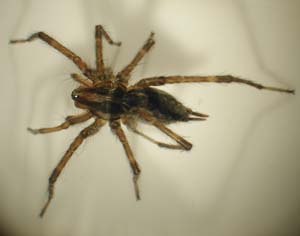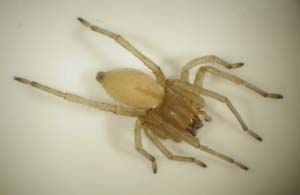|
|
|
|
Which ones are Brown
Recluses? |
|
|
|
All photographs
copyright Ken Cramer. Photos may be used for educational
purposes by contacting Dr. Cramer (kenc@monm.edu) for permission and properly
acknowledging the source. |
|
|
 |
|
 |
| Nope.
This is Trachelas. Note the reddish-brown forelegs and
dark, shiny cephalothorax. |
|
No --
this is Herpyllus, the Parson's spider. Black body with
typical white markings, and large, easily visible spinnerets (at
back of abdomen). |
| |
|
|
 |
|
 |
| Yup. This
is a brown recluse. The signature small, dark violin on the cephalothorax is there. Also the hairless legs and the uniform
color elsewhere on the body, and the posture are typical. |
|
Mmmm,
nope --
this is a funnel-web spider. Note the spines and hairs on the
legs, the long, noticeably elongate spinnerets, and stripes or other markings on the body as well as the
legs. |
| |
|
|
 |
|
 |
| Sorry.
This is Cheiracanthium. Pale, yellow or even greenish
tint, and black "feet" distinguish this spider. |
|
A common mistake, this very
large, fast, and hairy spider is a wolf spider. Although this
specimen has an almost two-inch leg span, others wolf spiders are
smaller. Hairiness, large size, and large visible eyes tell you this is no
recluse! |
 |
|
 |
|
This black beauty is a common
jumping spider in our area. Note the blocky head region and
fuzzy body. They live up to their name with tremendous leaping
ability. They have keen eyesight and will often turn and face
a human or any moving object. |
|
This woodlouse spider is often
submitted for identification. The large chelicerae and reddish
body and leg color are most noticeable. A common household
spider, it was imported from Europe accidentally and has done quite
nicely here, thank you. Apparently, it likes to eat woodlice (rolly-pollys
or pillbugs). |
|
|
|
|
 |
|
|
|
